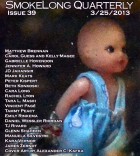What stays with me after reading “Copper Heart” is the beauty of the images and the sadness of the content. What first inspired you to write this—an image, the content, or another source? Can you talk a little about its genesis?
The story came first from a conversation I had where someone had become fascinated with sketching possible suicide sites. I found that idea in my journal a year or so after recording it and messed around with it as a poem. The flash I write seems always to begin as a poem because it can’t really be a story until I have an image that strikes me. The copper heart clanging and echoing and the sound of the sister’s voice came from the poem.
“Clanging copper heart” really does sum up the story. Another thing I like is the character of the woman listening to her suicidal sister. She seems to understand that there is very little she can do about this situation. Attitude is so important to stories. I’d like to know about how you arrived at this particular attitude of acceptance. How do you approach “character” in your stories?
Many writers have written in any number of writing books that a writer has to know “everything” about a character, even what brand of orange juice she drinks. While I don’t believe in this literally, I do end up knowing background experiences for characters that never make it into the story. For example, for this character I had a strong sense of birthdays when her sister has not called her and of nights when she called in a much more frantic, desperate way. I suppose that comes from watching people, thinking about how we get along, what we say and do to each other. Then it becomes a process of putting the character in a specific place and time where the details for this single encounter emerge. I like the idea that flash captures an almost singular moment in a character’s life, but must also convey a much wider sense of experience, a little like paintings where a life unfolds in the fruit on the table’s edge or the angle at which the plowman stands.
You mentioned that you teach and also have children, so I know you are extremely busy. How do you manage your writing time?
The initial thought to this question is “never to my satisfaction.” So I have to say the first step for me has been acceptance about what I can accomplish given the other moving parts of my life. But I also keep some pressure on myself or I would never write anything at all. My basic idea is to try and write a little bit every day and sometimes appreciate that a little bit turns into more. I have been dedicated to my journal for more than twenty years and have fifty-seven volumes in composition books. Some days I write nothing worth reading again, other times, I get back from a walk, a day at school, a gymnastics meet, and I have impressions to record. I go back into journals and find things I’ve written that suddenly strike me as a good idea or image, and I mess around to see what happens. I use writing books with exercises, too. My day feels better when I get a few pages of writing in the journal, and it feels close to perfect if I move something from the journal to a draft or open a draft and work my way toward something that feels finished. It goes along slowly, but it’s there.
Who do you read and what have you learned from them?
Annie Lamott and Natalie Goldberg were some of the first writers on writing that I read. I still go back to them often, mostly because they make the process of writing and making mistakes normal, even necessary. I like Julia Cameron, too, her morning pages and artist’s dates are practices I try to have in my life. Stephen King’s memories of being a kid and how they inform his writing are terrific. All these books have given me reassurance that writers work hard, doubt what they’re doing, and keep going. They also play and keep their pens moving across a page. There is a sense of community and generosity in these books that I love. I can read a couple pages pretty much from any book on writing and find myself ready to put something down. I’m sure I’ve taken specific techniques from them as well. And certainly the fiction and poetry I read give me a sense of how much is possible with language. But mostly, I love feeling connected to print through these books and the process of thinking about my own work.
What do plan for your future as a writer? Is there a novel there or a collection of stories?
I do have a draft of a novel that needs quite a bit of structure work and revision and the start of another novel. It feels a little difficult to find the sustained energy that I think a novel requires in my present life. That’s why flash and poetry appeal to me so much. I can manage them a little better in the short bursts of time I have to work. I don’t have to hold so much in my head and create the same kind of consistency. But I do like the idea of a book, so I have been fooling around with poems and flash to see how they might fit as a collection. It’s ironic because I read novels constantly and love them. Maybe I’m just a little lazy in that area or I haven’t hit on the right idea yet.



 The core workshop of SmokeLong Fitness is all in writing, so you can take part from anywhere at anytime. We are excited about creating a supportive, consistent and structured environment for flash writers to work on their craft in a community. We are thrilled and proud to say that our workshop participants have won, placed, or been listed in every major flash competition. Community works.
The core workshop of SmokeLong Fitness is all in writing, so you can take part from anywhere at anytime. We are excited about creating a supportive, consistent and structured environment for flash writers to work on their craft in a community. We are thrilled and proud to say that our workshop participants have won, placed, or been listed in every major flash competition. Community works.